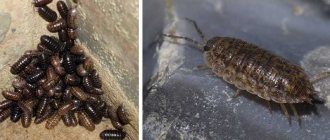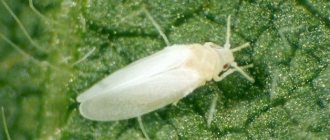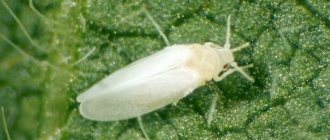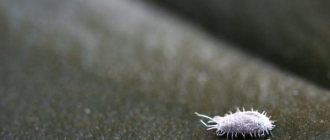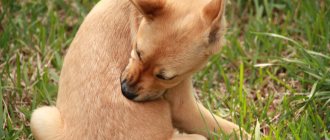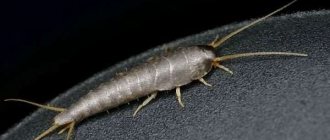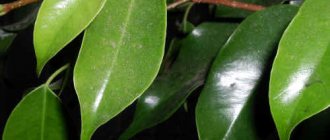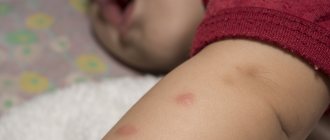What are earth fleas?
This type of flea got its name because of its habitat, but in appearance they are similar to their relatives that live on rats, dogs, cats and other animals.
What they look like
The body length of an adult flea reaches 2-3 mm. Males are smaller than females. The parasite is covered with a durable chitinous carapace of dark brown color. Its body is flattened laterally, which provides good streamlining when jumping.
The body of an insect, consisting of 3 sections, incl. head, chest and abdomen, characterized by an ovoid shape. The abdomen has the largest volume, because it fills with blood as the parasite feeds. The earth flea has 3 pairs of legs. They have serrations that help them cling to the fur and skin of the victim.
Only the hind legs - the longest ones - are used in jumping. The parasite covers a distance of 25-30 cm in one movement. It is believed that it is capable of jumping 75-100 cm in height. The flea, using its hind legs, shoots itself, so its jumps are chaotic.
Parasites have poor vision, but the sensory apparatus present on the back of the abdomen helps to detect even minor vibrations.
In addition, fleas are able to smell the blood and sweat of a victim at a distance of 2-3 m.
Adults have a piercing-sucking apparatus. When attacked, the parasite first pierces the skin and injects a special enzyme that prevents blood clotting and causes severe pain. After this, the flea expands the wound with blades and begins to feed, pumping blood into the expanding abdomen.
What do they eat?
Adults feed only on the tissue of warm-blooded animals. A flea can consume up to 1 ml of blood in one bite. For normal life, the parasite needs to feed at least once every 2-3 days. He makes many punctures on the skin of the legs until he finds a place where the vessels are located close to the surface.
How do they reproduce?
The breeding season for parasites lasts from mid-April to the end of September. During her life, a female can produce up to 500 eggs. Although adults are ready to mate immediately after emerging from the cocoon, the female must first find a warm-blooded animal and bite it. If the act of feeding has taken place, after about 48 hours the flea finds a secluded, cool place with a sufficient level of humidity and begins laying.
It can contain up to 40-50 eggs, covered with a special protective white shell. The eggs of parasites are oval in shape and their size does not exceed 0.1 mm. Under favorable conditions, larvae quickly emerge from them. In most cases it takes no more than 2-10 days.
Flea larvae resemble small worms covered with sparse hairs. They feed on decaying organic matter. After 7-21 days the larva pupates. A flea can spend from 7 to 200 days in the form of a pupa. If conditions are favorable, the insect quickly emerges from the cocoon, becoming an adult.
How long do they live?
Life cycle of a flea.
The lifespan of a flea depends on external conditions. Individuals overwintering in deep layers of soil often die during frosty and snowless winters. Under favorable conditions, they can live 1.5-2 years.
Preventive measures
You can protect indoor plants and prevent pests by following certain preventive measures:
- Water the plants regularly, but do not allow the soil to become waterlogged;
- purchase soil for flowers only from trusted manufacturers;
- You should not fertilize the soil with organic compounds; for this purpose it is better to use special fertilizers;
- water the flowers only with clean water;
- the soil needs to be loosened periodically;
- remove old inflorescences and leaves from plants;
- Large plants should be replanted twice a year, and small ones - no more than once.
Photo of an adult fool with multiple magnification
To be fair, it should be noted that only some species of collembola are classified as pests. But there are springtails that eat nematodes and enchytraeids, thereby bringing benefits. Insects feeding on rotting organic matter improves soil formation. The white fool is one of those four species of “brothers” that stand out for their harmfulness from the more than 4 thousand that live on earth. We can talk about the danger of insects in the case of a sharp growth of the colony, when there is not enough rotting residue in the pots to feed, and the thinnest thread-like roots of the root system begin to be eaten. Most often, orchids, violets, and gloxinias fall into the risk zone.
Attention! The appearance of springtails in indoor flowers is an indicator of waterlogged soil in pots and flowerpots and improper care of plants.
Habitats
Ground fleas live in the soil . In winter, they bury themselves 15-20 cm into the ground and pupate. With the onset of warmth, they leave their cocoons and move to the upper layers of the soil. An increase in their numbers is observed when it rained for some time, and then the heat came. High air temperatures and high humidity are the most suitable conditions for these insects. Adult parasites begin to search for a victim.
Fleas don't only live in the ground. They can be found and reproduce in human homes. They live in rooms with high humidity. They attack apartments on the first floors. They are especially common in homes where people neglect sanitary standards.
Good hiding places for them:
- a pile of clothes;
- cracks in the floor;
- folds of upholstered furniture;
- long carpet pile, etc.
In addition, fleas choose outbuildings. They live in animal bedding and places where old things are stored.
Why do indoor flowers get midges?
The main reason for the appearance of these small insects, as a rule, is constant waterlogging of the soil when watering indoor plants.
Other reasons include the following:
- contaminated soil. You can bring these pests home in a pot when purchasing a new plant or just a bag of potting soil;
- moisture-absorbing soil. The presence in the soil of a large number of ingredients that can retain moisture during irrigation - high-moor or low-lying peat, coconut chips, sphagnum moss, vermiculite;
- the presence of unrotted remains of leaf or coniferous humus in the soil. In combination with excessive watering, the most favorable environment for the reproduction of pest larvae appears in a pot with such soil;
- open window. Flying fungus gnats can fly into a room from the street and, finding wet soil, happily settle in your flower pots.
Find out in detail how to remove fleas from an apartment and what preventive measures exist.
All the most effective methods of baiting cockroaches are described in this article.
The danger of insect bites for humans
Biting insects such as fleas are extremely dangerous because... are carriers of many infectious diseases that require long-term treatment.
Among them:
- plague;
- encephalitis;
- listeriosis;
- anthrax;
- typhus;
- tuberculosis;
- hepatitis;
- tularemia.
Flea bites.
Flea bites are a source of helminthic and fungal infestation. The parasite injects its saliva during feeding. The bite site is very itchy and may become red. People who are sensitive to the enzymes present in the saliva of these fleas may experience allergic reactions.
First aid
The feet, ankles and ankles are the most common sites where the legs are affected. Areas of insect attack may be invisible, but damage to the skin is indicated by itching. If there are no severe allergic reactions, bites can be treated at home.
The affected area must be treated with a disinfectant. A cold compress helps relieve itching. In addition, it is recommended to use an ointment that includes antihistamines. If signs of allergy or intoxication of the body appear, you cannot carry out treatment on your own; you should seek medical help.
If fleas have bitten a child
Focal redness appears on children's skin at the sites of bites. The child experiences severe discomfort due to itching. Bite areas must be treated with a disinfectant and a cold compress applied. If there are many areas of damage, you should consult a doctor, because... Antihistamines may be required to relieve symptoms.
How to get rid of fleas in a house with a child
Some commercial insect repellents can cause a severe allergic reaction in a child, so such products should only be used if the child is not present.
In other situations, it is better to use safer methods, for example:
- Buy repellents that contain natural substances, for example: wormwood, cedar oil and mint.
- Buy shampoo based on eucalyptus, juniper, lavender and geranium. Children love to hang out with pets, so pets need to be bathed regularly, thoroughly washing the neck and chin. After bathing, the animal must be treated again. To do this, you need to prepare a solution in advance: boil one lemon in half a liter of water, leave the solution for seven hours.
- It is necessary to regularly ventilate the room, carry out general cleaning, and heat treat children's clothes with an iron.
- It is important to wash outdoor shoes, paying special attention to the soles.
Such recommendations will protect your apartment from fleas.
Methods of disposal
If the number of fleas in a residential area is small, you can fight them with chemical insecticides. There are many effective means that can be used to poison these insects, but when using them, some precautions should be taken to avoid poisoning. If this option is undesirable, you can use folk remedies to kill fleas.
In apartments on the first floors, even with the use of folk and chemical remedies, fleas appear again after a short time. This indicates that the basement is infested with them. In this case, fighting with simple methods will not help and you should turn to professionals to thoroughly disinfect not only the apartment, but also the areas underneath it.
Professional pest control
Professional pest control is the most effective. Experts agree to poison insects even in large rooms. They use special equipment and potent insecticides that can destroy not only adults, but also eggs, larvae and pupae. Many companies provide a guarantee for their services and, if necessary, carry out repeated disinfestation free of charge.
Chemicals
The most common method of killing fleas is to treat the premises with chemical insecticides. They are available in the form of powders, concentrates, aerosols, drops, and emulsions.
Option for a remedy for earthen fleas.
Insect control can be carried out with the following drugs:
- "Clean house".
- “Butox 50”.
- "Raptor".
- “Ecokiller”.
- "Phenaxin".
- “Nats.”
- "Raid".
- "Combat".
- "Dichlorvos".
It is difficult to determine which product is the best. One treatment with any of these drugs does not always give a good result, because... they are unable to destroy flea eggs. To achieve a positive effect, it is advisable to carry out 2-3 procedures with an interval of 5 days.
Folk remedies
Folk remedies that help repel fleas are recommended to be used when the number of insects in the house is small. To poison parasites, you can prepare a mixture of soda and salt. The components are taken in equal proportions. The composition should be thoroughly treated with all carpets and sprinkled in corners and on the floor in the basement. Turpentine can be used to treat outbuildings.
Herbal products are also effective in controlling fleas. A decoction of wormwood and tansy helps to quickly eliminate parasites. To prepare it, 2 cups of wormwood are mixed with 1 cup of tansy and 1 cup of eucalyptus.
The composition must be filled with 10 liters of hot water. The mixture is boiled for 3-5 minutes. After this, the container with it is removed from the heat, wrapped in a blanket and left to infuse for a day. The finished product should be filtered, poured into a spray bottle and used to treat the room.
To repel fleas, it is recommended to place spruce and pine branches in the corners of the living room. These insects cannot tolerate the smell of pine needles. To treat the room, brewer's yeast and garlic are used, mixed in equal proportions. The mixture should be rubbed onto all places where fleas can enter the house.
Folk remedies for fleas.
Prevention is a preventive method of control
Timely prevention will help to avoid the appearance of springtails and podura in indoor plants.
A large population of white fools is the cause of illness in indoor pets
- The outer surfaces of flowerpots and pots, flower shelves, window sills, and stands are wiped with detergents.
- Preliminary watering of the soil with hot water is organized before planting flowers. Larvae and adults brought with the soil are destroyed.
- If necessary, the old soil is completely replaced with new one.
- The dosage of organic fertilizers, a potential food for springtails, is strictly observed.
- Organization of moderate watering and frequent loosening of the soil.
- When replanting plants, the soil is treated in advance, and the flower container is equipped with an effective drainage system that prevents stagnation of water.
- If necessary, the lump of earth on the root is dried in a shaded place in the breeze or blotted with soft paper.
- Rotten roots must be cut off.
- To prevent the reproduction of insects, containers for flowers are chosen of a suitable size, free of voids in which fungus, bacteria and other food for the fool can develop.
- For the purpose of prevention, planted (or transplanted) flowers are watered with an aqueous solution: 1 liter of liquid and 4g of Fitosporin.
Often, increased indoor air humidity occurs due to water supply leaks and faulty shut-off valves. Therefore, measures are being taken to eliminate them. Ventilation of rooms to ventilate plants should not be neglected.
Preparing the premises
An important condition for achieving a good result is careful preparation of the room for processing. All unnecessary old things and garbage should be thrown away. It is advisable to vacuum the floor. It is recommended to knock out carpets. In addition, be sure to treat all surfaces with soapy water.
Furniture should be immediately coated with special agents that repel parasites. Products must be refrigerated during disinfection to prevent chemicals from coming into contact with them. After this, you should close all windows tightly and begin processing the room.
